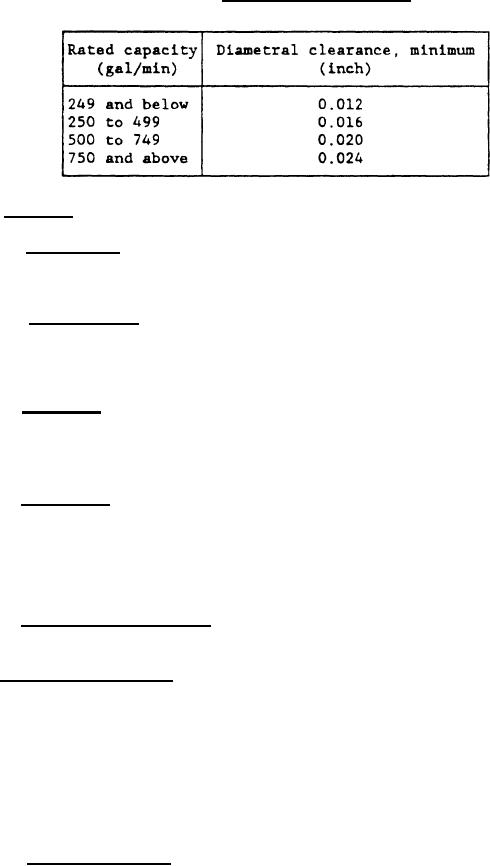 |
|||
|
|
|||
| ||||||||||
|
|  MIL-P-18472G(SH)
TABLE I. Diametral clearance.
3.3.6 Shafts.
3.3.6.1 Threading. Shaft threading, except threading for rolling contact
bearing locknuts, shall be counter to the direction of rotation. Shaft threading
for rolling contact bearing locknuts may be clockwise or counterclockwise.
3.3.6.2 Tachometers. The shaft (pump or driver), except those driven by ac
motors, shall be provided with means to permit the ready and direct use of
portable tachometers. When this is impracticable, provision shall be made for
the use of a portable tachometer on the shaft of the driver.
3.3.6.3 Sleeves. Shafts shall be fitted with shaft sleeves in way of all
wearing surfaces, such as stuffing boxes, bushings, and water lubricated
bearings. An O-ring seal shall be installed between the shaft and stuffing box
(including mechanical seal) shaft sleeve.
3.3.6.4 Flingers. Shaft flingers shall be provided adjacent to the gland
for all pumps. The flinger shall be so located that leakage which might occur
between the gland shaft sleeve and the shaft, as well as from the gland, is not
allowed to reach pump or motor ball bearings. For rigid coupled units, the
coupling may serve as the pump flinger provided the coupling is constructed of
corrosion-resistant material.
3.3.6.5 Close-coupled pumps.
Shafts of close-coupled pumps shall be of
one-piece construction.
3.3.7 Rotating assembly. Rotors shall be dynamically balanced with all
rotating parts connected thereto; for common shaft assemblies, or those using
rigid coupling, this requires dynamic balance with the rotating element of the
driving unit in place. However, rotating parts may be balanced individually
provided that, when assembled, the imbalance shall not exceed the limits
specified in MIL-STD-167-1. Where balancing is required as a maintenance
procedure to maintain proper vibration or noise performance of the pump and
driver unit in service, the pump shall be configured so that balancing may
readily be performed by overhaul activity personnel.
3.3.7.1 Operating speed. The pump construction shall be such and calcu-
lations shall be made to demonstrate that the maximum operating speed of the
pump is not greater than 70 percent of the first critical speed.
|
|
Privacy Statement - Press Release - Copyright Information. - Contact Us |